
Alex Berg, CEO, Fell Swoop
Many of the retailers thriving online sell considered products that consumers often think carefully about before purchasing. Online tools that guide shoppers to the right product can be a big conversion booster. Here are three examples that do it well, even if they each miss an occasional opportunity to provide helpful information.
Brooks wisely merchandises its 100% satisfaction guarantee—removing any doubt for customers who might be leery of making such a personal purchase online.
With Amazon dominating the sale of commodity items (and so much more), it’s not surprising that the independent retailers that are surviving and even thriving are those that sell considered or specialized items that often call for a high-touch experience.
It hasn’t come easily. Guiding customers through complex purchase decisions requires in-depth customer knowledge, a willingness to experiment, and real financial investment. The complexities of highly considered sales are very real. From emotional and shared decisions such as housing to the technical and research-oriented aspects of consumer electronics, the examples are myriad. The good news for e-retailers is that patterns have started to emerge. The necessity of maximizing ephemeral visits and converting empowered customers has spawned invention.
Different sites approach the problem in their own unique ways; some focus on integrating educational content directly into a traditional buy flow, while others bring in the experts, offering online and even offline consultations at their stores. Others, and those featured in this article, invest in crafting custom recommendation engines to guide customers to a tailored set of products.
What follows is a review of three recommendation experiences starting with the simplest and concluding with the most robust. There are common threads across all, but each has a few unique moves, as well as some missed opportunities.
Carvana
The online car-buying site Carvana isn’t without ambition. Buying a car online is one of the exemplars in high-consideration decisions. For many the process is expensive, complex, and a shared decision with a loved one. But Carvana didn’t stop at tackling that problem, they also are trying to put traditional dealerships out of business by bypassing them and going direct to the consumer.
As product recommendation engines go, Carvana’s is simple, but it does a couple of important things well. Its wizard wisely begins with an easy question, but also one that quickly sets the field, asking which attributes are most important to you.
Carvana asks you to rank these inputs to help their algorithm get the best possible recommendation; without this it would be hard to weigh attributes like safety over performance. The wizard smartly displays a status indicator showing where you are and what step is next.
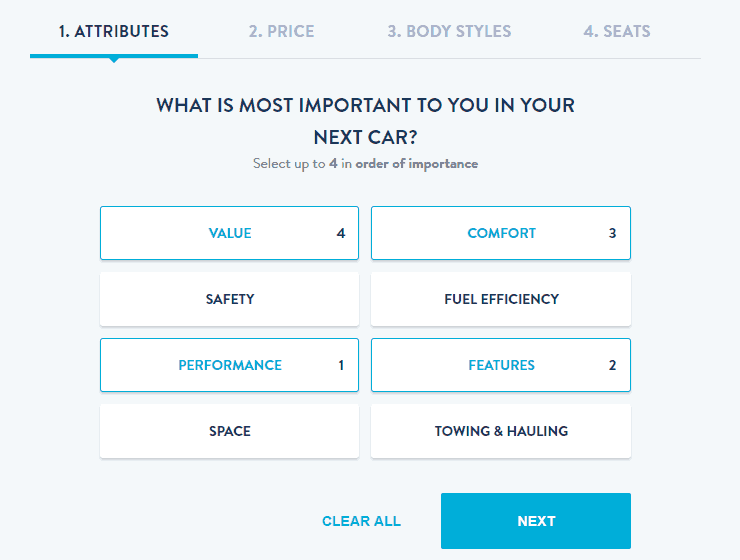
The subsequent steps, covering price range, car body style, and number of seats, are light on guidance, but are questions most consumers will have easy answers for. Throughout the experience you can easily revisit previous steps or indicate when you don’t have a preference—this capability, as well as a status indicator, should be a standard for any product recommendation experience.
The final recommendation set does two noteworthy things. First, Carvana recommends a singular car as the top choice and provides four logical alternatives. Users can easily shop inventory, if they are seriously considering their options, or view more details on each car.
Second, and most notably, each option has a handy single sentence descriptor setting it apart from the other choices. This simple notation helps facilitate trade-offs for consumers—fully delivering on the promise of the experience.
As experiences go, it’s solid and nails the basics—the recommendations seem sound and rooted in my inputs. It is, however, not without a few missed opportunities. The % match scores for each car go unexplained. I’d like to see the ‘why’ behind my results.
The cars also cannot be easily compared side-by-side which would be handy. Finally, my options cannot easily be shared or saved for later; although that is somewhat mitigated by my relatively easy ability to reproduce the results.
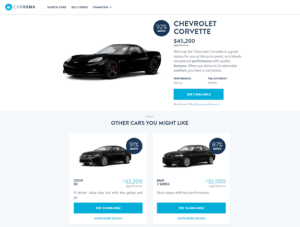
Best Buy
A more robust and content-rich recommendation engine can be found in Best Buy’s ‘Find the Perfect TV’ offering. Like Carvana, Best Buy starts with an easy question to give the user a sense of momentum. Customers are asked which room their TV will be in and provided with inline guidance, including measurement ranges for each room with a single sentence of supporting rationale. Outdoor TVs, for instance, are filtered for those suited for temperature variance and condensation. Smart.
Best Buy also doesn’t miss an opportunity to message some compelling contextual benefits such as free delivery and in-store pickup.
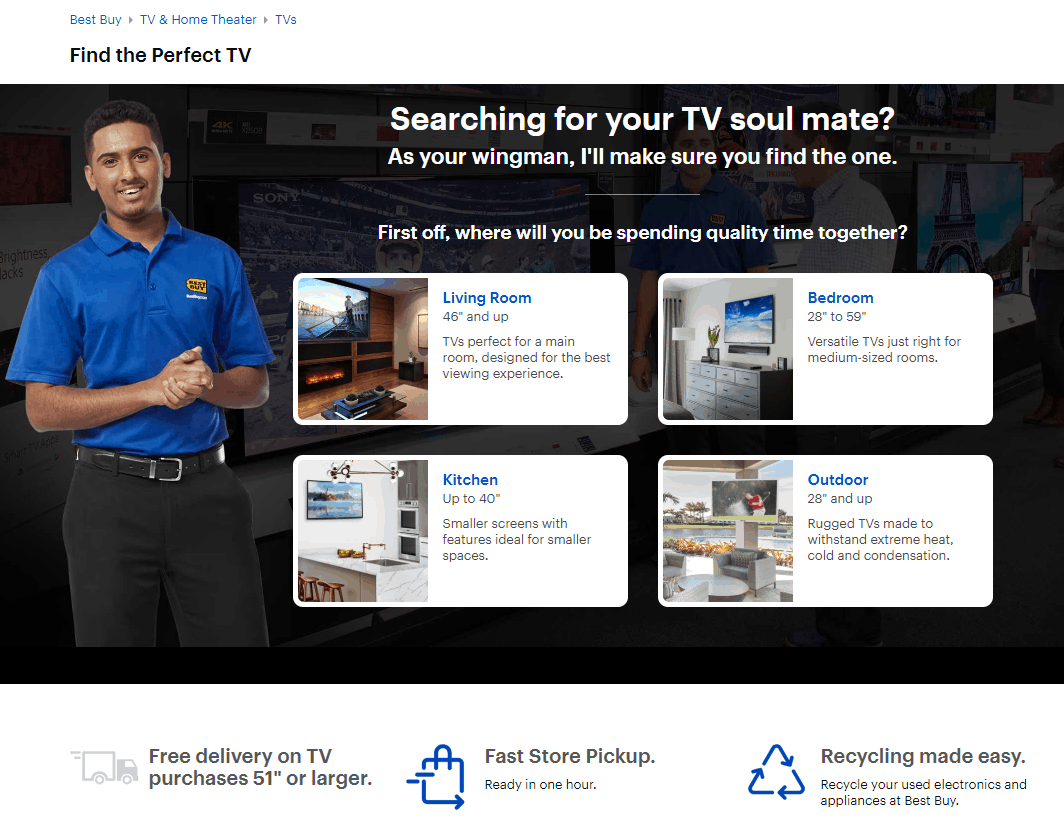
As you progress in the experience, Best Buy continues to educate you as you go. Not clear on industry jargon like refresh rate? A contextual definition keeps you on the path. Curious on how each choice impacts your option-set? Real time inventory counts adjust with each choice.
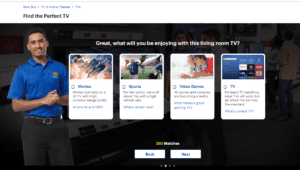
By letting clarifying questions unfold as you go, they take an experience that could feel overwhelming and makes it feel progressive and thoughtful.
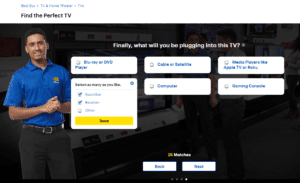
While Best Buy’s final recommendation set is arguably too deep to be helpful (25 choices, Best Buy?) the retailer does offer a handy set of filters for key features along with supplemental definitions should you need contextual help.
The recommendation engine would benefit from a more Carvana-like approach wherein the recommendations are ranked. Best Buy should also consider integrating some side-by-side comparison tools to help consumers reach their own conclusions or offer help via an online or in-store expert—it’s a perfect opportunity to leverage the Geek Squad.
Both present opportunities to capture valuable user information to remarket to them in subsequent sessions. Such lead-generation vehicles are particularly helpful in high-consideration sales as they seldom take place in a single session.
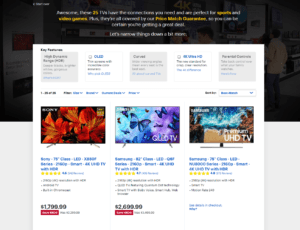
Brooks Running
The final, and best example comes from Seattle-based running shoe and apparel retailer Brooks Running. Brooks obsesses about running and it’s evident in the care it took to craft an exceptional ‘Shoe Finder’ experience.
Starting with a bold claim, “Your perfect shoe is out there,” Brooks makes a promise to deliver, but also wisely lets the attention span-challenged visitors they’ll need to invest 5 minutes of their time. It’s an appropriate heads-up considering how thorough the experience is.
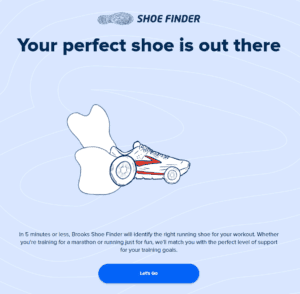
The steps, while far longer, are well illustrated and animated, which not only lead me along the path to the right shoe, but also built brand regard.
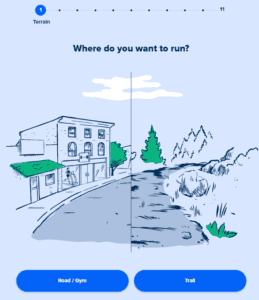
The questions on recent injuries let me know Brooks knows runners. And the “Behind the Science” explanations instill confidence in the company’s expertise.
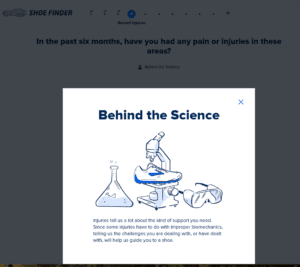
As recommendation wizards go, Brooks is far more involved than Carvana and Best Buy combined, but that’s by design. Brooks knows first-hand how intensely personal a choice a running shoe is. And while it might have been easier to cut figurative corners, the company knows there’s no substitute for good intel—even if that means asking website visitors to take off their shoes for stride analysis.
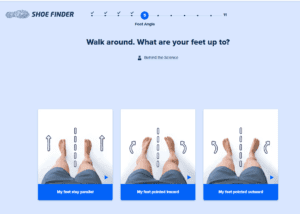
Or even to do some quick squats.
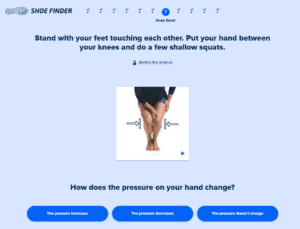
Questions on shoe impact and feel are expressed in the form of “I want” statements demonstrating Brooks’ customer-centric approach.
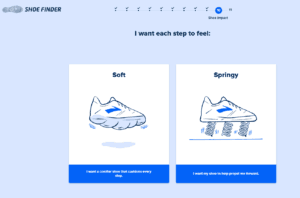
As for the final recommendation, Brooks hits all the right notes. The shoe finder provides a set of ordered recommendations that don’t overwhelm and share the supporting rationale. Brooks doesn’t stop at just letting you edit your results, you can save them. That’s a smart move considering the time spent in arriving at them.
The recommendations are slugged with helpful, scan-friendly labels on each shoe’s essential characteristics. Additional details are upon request without requiring you to leave the page. Finally, Brooks also wisely merchandises its 100% satisfaction guarantee—removing any doubt for customers who might be leery of making such a personal purchase online.
Look across these examples and you’ll find some common moves; an indication of status, integrated guidance as you go, and the ability to revisit previous selections. However, each has some standout moves the others could learn from.
Carvana’s pithy summaries on each car help consumers make trade-offs. And their % scores further guide selection. Best Buy’s real-time inventory feedback shows you the implications of your decisions and their elaborating questions unfold progressively. And, finally, Brooks ‘Behind the Science’ stands alone as the best example of demonstrating how the inputs drive the outputs.
Overall, Brooks is at the head of the class thanks to its combination of a robust approach, rich product guidance, thoughtful and brand-friendly design, and well-crafted recommendations. E-retailers take note.
Fell Swoop is a UX design firm in Seattle focused on ecommerce.
Favorite